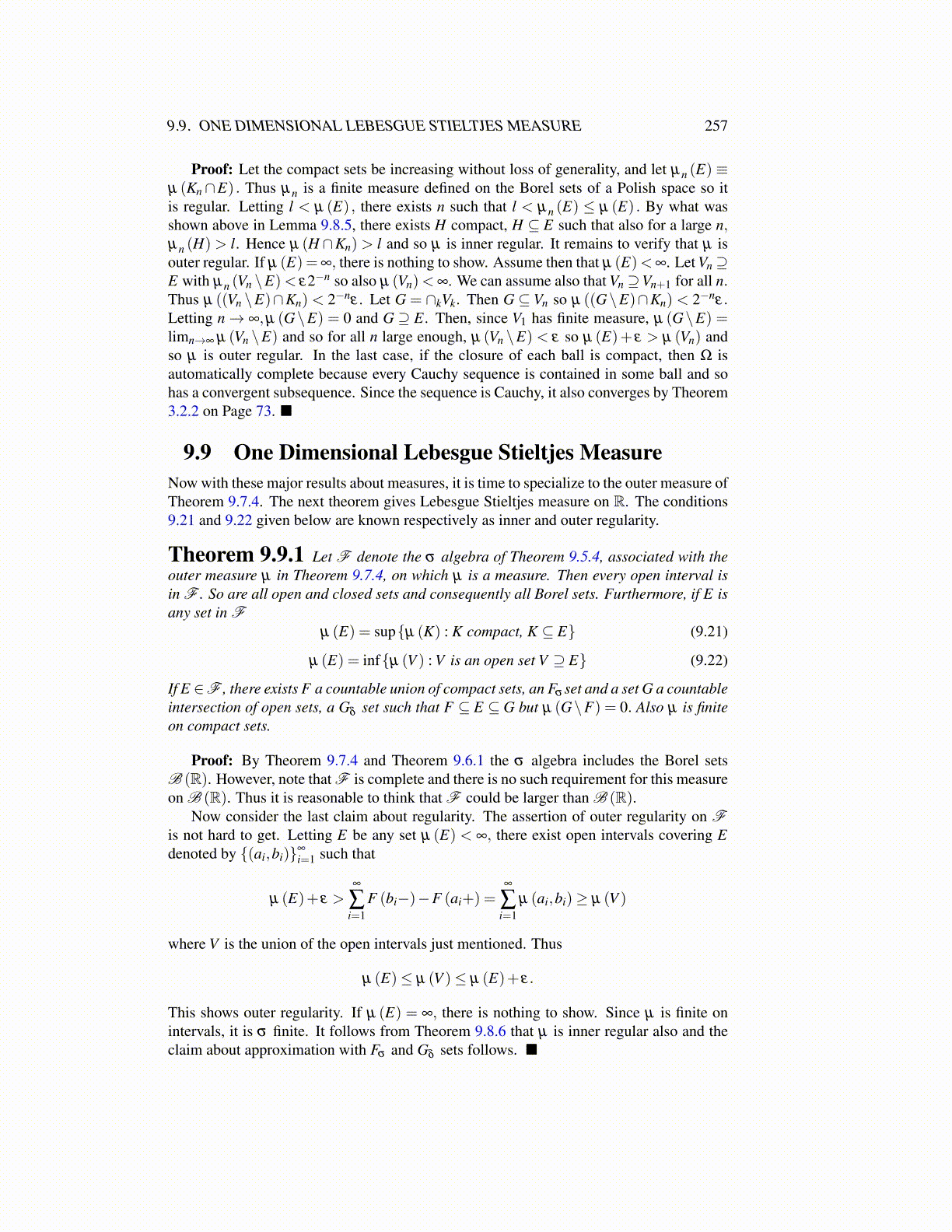
9.9. ONE DIMENSIONAL LEBESGUE STIELTJES MEASURE 257
Proof: Let the compact sets be increasing without loss of generality, and let µn (E) ≡µ (Kn∩E) . Thus µn is a finite measure defined on the Borel sets of a Polish space so itis regular. Letting l < µ (E) , there exists n such that l < µn (E) ≤ µ (E) . By what wasshown above in Lemma 9.8.5, there exists H compact, H ⊆ E such that also for a large n,µn (H) > l. Hence µ (H ∩Kn) > l and so µ is inner regular. It remains to verify that µ isouter regular. If µ (E) =∞, there is nothing to show. Assume then that µ (E)<∞. Let Vn ⊇E with µn (Vn \E)< ε2−n so also µ (Vn)< ∞. We can assume also that Vn ⊇Vn+1 for all n.Thus µ ((Vn \E)∩Kn) < 2−nε . Let G = ∩kVk. Then G ⊆ Vn so µ ((G\E)∩Kn) < 2−nε.Letting n→ ∞,µ (G\E) = 0 and G ⊇ E. Then, since V1 has finite measure, µ (G\E) =limn→∞ µ (Vn \E) and so for all n large enough, µ (Vn \E) < ε so µ (E)+ ε > µ (Vn) andso µ is outer regular. In the last case, if the closure of each ball is compact, then Ω isautomatically complete because every Cauchy sequence is contained in some ball and sohas a convergent subsequence. Since the sequence is Cauchy, it also converges by Theorem3.2.2 on Page 73. ■
9.9 One Dimensional Lebesgue Stieltjes MeasureNow with these major results about measures, it is time to specialize to the outer measure ofTheorem 9.7.4. The next theorem gives Lebesgue Stieltjes measure on R. The conditions9.21 and 9.22 given below are known respectively as inner and outer regularity.
Theorem 9.9.1 Let F denote the σ algebra of Theorem 9.5.4, associated with theouter measure µ in Theorem 9.7.4, on which µ is a measure. Then every open interval isin F . So are all open and closed sets and consequently all Borel sets. Furthermore, if E isany set in F
µ (E) = sup{µ (K) : K compact, K ⊆ E} (9.21)
µ (E) = inf{µ (V ) : V is an open set V ⊇ E} (9.22)
If E ∈F , there exists F a countable union of compact sets, an Fσ set and a set G a countableintersection of open sets, a Gδ set such that F ⊆ E ⊆ G but µ (G\F) = 0. Also µ is finiteon compact sets.
Proof: By Theorem 9.7.4 and Theorem 9.6.1 the σ algebra includes the Borel setsB (R). However, note that F is complete and there is no such requirement for this measureon B (R). Thus it is reasonable to think that F could be larger than B (R).
Now consider the last claim about regularity. The assertion of outer regularity on Fis not hard to get. Letting E be any set µ (E) < ∞, there exist open intervals covering Edenoted by {(ai,bi)}∞
i=1 such that
µ (E)+ ε >∞
∑i=1
F (bi−)−F (ai+) =∞
∑i=1
µ (ai,bi)≥ µ (V )
where V is the union of the open intervals just mentioned. Thus
µ (E)≤ µ (V )≤ µ (E)+ ε.
This shows outer regularity. If µ (E) = ∞, there is nothing to show. Since µ is finite onintervals, it is σ finite. It follows from Theorem 9.8.6 that µ is inner regular also and theclaim about approximation with Fσ and Gδ sets follows. ■